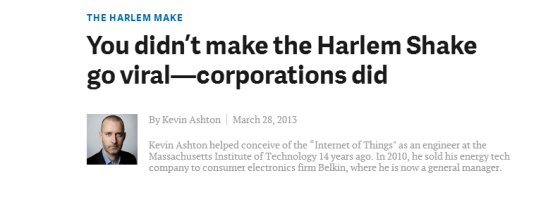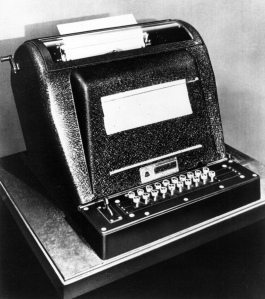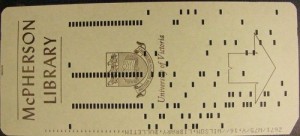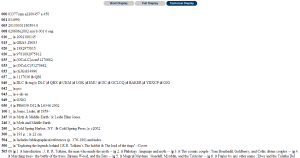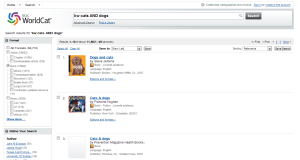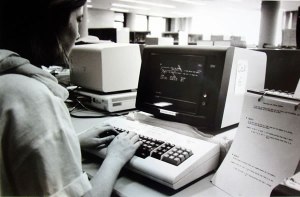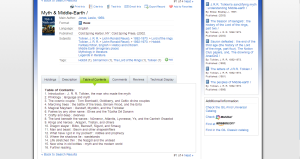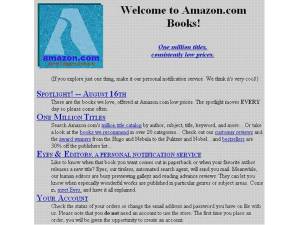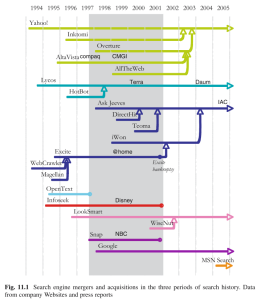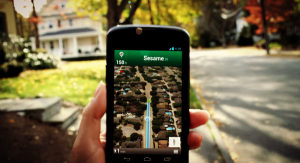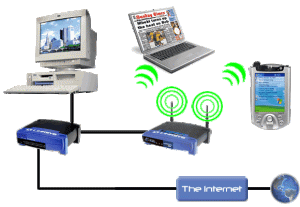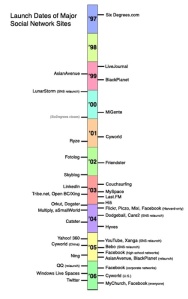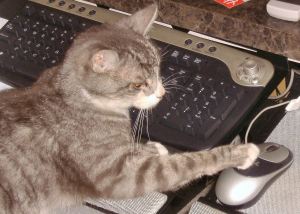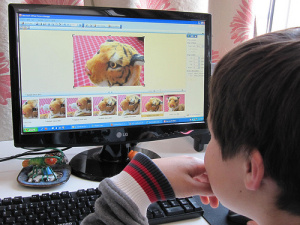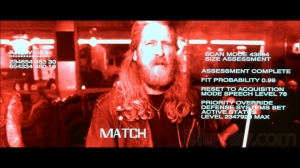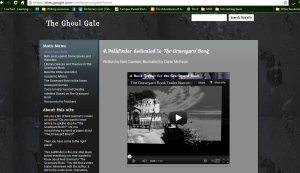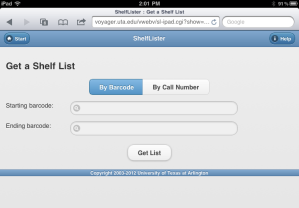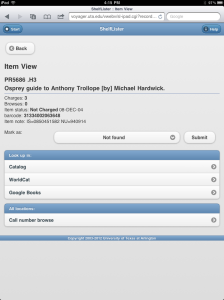I read an interesting article on how memes are born and promoted at Quartz this morning. I thought it might be worth sharing.
Timeline of Major Events in Library Computing
It is difficult to imagine a library today without computers. Most libraries devote at least part of their physical space to housing them. Patrons of all walks of life come to the library specifically to use them. Computers organize our collections, promote our collections, facilitate sharing of our collections, allow patrons to browse our collections, and – increasingly – have come to contain part of our collections. An exploration of the evolution of the computer-based library should consider not so much the hardware that makes it all possible, but rather the changes in how we use and think about computers. Physically the computers found in libraries are not significantly different from the computers found in banks, government offices, hospitals, homes, and schools; it is how we use them that makes library computing unique.
The Complex Number Calculator 1940
Bell Telephone Laboratories builds the Complex Number Calculator (CNC) which performed calculations remotely through the telephone lines. This invention would eventually lead to remote networking computers. (“Timeline of computer history”, 2006) (“1940: Complex number generator”, 2013)
The Complex Number Generator (“Timeline of computer history, 2006)
Online Reference Retrieval Systems 1964
In 1964, the first online reference retrieval systems begin to appear. Using standard telephone lines they can transmit requests, not for the actual articles or texts, but for bibliographic information about resources that fit the search parameters prescribed by the librarians conducting the search. (Drew, Summit, & Whiteley, 1966) (“Library technology timeline”, 2004)
A punch card of the style used in libraries in the 1960s (Google images)
MARC I 1966
The advance of computer-based cataloging and collection management could not proceed without a system of communicating bibliographic information that was concise and machine readable. MARC (Machine Readable Cataloging) was released in 1966 and a version is still being used today. MARC II followed quickly in 1968. (Rayward, 2002) (“A brief history of WorldCat”, 2013)
A MARC record (Connolly-Brown, 2013)
OCLC and WorldCat 1971
The collaborative efforts of librarians and computer programers in the late 1960s and early 1970s lead to the creation of the OCLC (Ohio College Library Center) Online Union Catalog (OLUC) that would eventually come to be known as WorldCat. OLUC allowed sharing, via telephone lines, the collections of several libraries. (OCLC, 1980) (OCLC, 2013)
WorldCat as it appears in 2013 (Connolly-Brown, 2013)
Electronic Resources 1970s
Beginning in the 1970s, libraries began to have access to electronic, index resources such as journals, magazines, and newspapers. Over the next 40 years access would only get faster, cheaper, and more reliable. Today patrons can access these resources from their homes. (Burke, 2009) (Flynn, 2011)
OPAC/ILS 1983
The introduction of the Online Public Access Cataloging (OPAC) and Integrated Library Systems (ILS) meant that patrons no longer needed to rely on librarians to conduct searchers for them. In most cases, patrons could search not just books, but serials, microfilm, and other collections using the OPAC. (Byrum, 2005) (Eberhart, 2000)
A patron using the online card catalog in the 1980s (UW Madison Libraries, 2013)
An library OPAC in 2013 (Connolly-Brown, 2013)
Commercial Internet 1991
The World Wide Web was born in 1990 and 1991 saw the first commercial use of the internet via dial-up modems that transmitted data at a rate of 56 kilobits per second. The internet was quickly adopted though the “web” would not be easily searchable for some time yet. (“Timeline of computer history”, 2006) (Rayward, 2002)
Amazon’s homepage in 1994 (Telco 2.0 Research, 2009)
Online Search Engines 1994
The early internet was not indexed and therefore files had to be shared largely through FTP and knowing the exact address of a site. Though not the earliest attempt to index the World Wide Web, Webcrawler, introduced in 1994, was the first web directory to search the entire text of a website. (Sonnenreich, 1997) (Jaworski & Sullivan, 2010) (“A short history of search engines”, n.d.)
Timeline of search engines until 2005 (2013)
Mobile Computing Devices and Apps 1996
Personal computing devices, beginning with devices such as the Palm Pilot, become available around 1996 and quickly become mainstream. By 2012, 45% of Americans owned a smart phone with the ability to access the internet and mobile apps. Library specific mobile apps are used for variety of purposes. (Pew Internet, 2013) (Montecino, 2010)
The Nexus 4 being used for GPS navigation (Nexus 4, 2013)
IEEE 802.11 Implementation (Wireless) 1997
The first standardized wireless protocol IEEE 802.11 is released for public use and quickly changes how patrons and librarians use computers but untethering computer devices and allowing for more mobility of computing. (IEEE, 2012) (Burke, 2009)
An example of a mixed wireless network environment today (Pocket PC Central, 2008)
Social Media 1997
Social networking as it is as old as the internet, but the first social media site widely available to the public was SixDegrees.com where users could create a profile and connect with their friends. Today most libraries have a presence online in social communities where they connect with their patrons. (Oggolder, 2012) (Boyd & Ellison, 2007)
Launch dates of major social media sites (Oggolder, 2012)
Conclusion
The 21st Century library is increasingly becoming a place in which technology and computers play a vital role in how patrons interact with information and resources and how librarians provide those resources. Charting the chronology of the most important events in library computing is a difficult task as computing has historically evolved in leaps and bounds, fits and starts. Several inovative minds will often come to the same eureka! moment almost simultaneously and technology follows suit. However, without an understanding of where they have been and a willingness to learn and adapt, libraries of the future cannot possibly hope to continue to to play a dynamic, relavent role in the lives of their patrons in the years to come.
References
Amazon homepage 1994 [online image]. (2012). Retrieved from Telco 2.0 Research, March 14, 2013, from http://libguides.gwumc.edu/content.php?pid=168844&sid=1421729
“A short history of search engines”. (n.d). Retrieved March 12, 2013, from http://comminfo.rutgers.edu/~ssaba/550/Week05/History.html
AT&T Labs. (2013). “1940: Complex number generator”. Retrieved on March 2, 2013, from http://www.corp.att.com/attlabs/reputation/timeline/40generator.html
Boyd, D. M., & Ellison, N. B. (2007). Social network sites: Definition, history, and scholarship. Journal of Computer-Mediated Communication, 13(1), article 11. http://jcmc.indiana.edu/vol13/issue1/boyd.ellison.html
Burke, J. (2009). Library technology companion (3rd edition). Chicago: Neal-Schuman.
Byrum, J. D. (2005). Online catalogs and library portals in today’s information environment. Journal of Library Administration, 43(1/2), 135-154.
Computer library catalog [online image]. (2013). UW – Madison Libraries. Retrieved March 10, 2013, from http://www.college.library.wisc.edu/about/faq/history.shtml#images
Cooke, M. (1977). Future library network automation. Journal of The American Society For Information Science, 28(5), 254-258.
Drew, D. L., Summit, R. K., & Whiteley, R. B. (1966). An On-Line Technical Library Reference Retrieval System. American Documentation,17(1), 3-7.
Eberhart, G. M. (2000). The whole library handbook 3: current data, professional advice, and curiosa about libraries and library services. Chicago: American Library Association.
Eden, B. (2007). Reinventing the OPAC. Library Technology Reports, 43(6), 13-40.
Elrod, J. (1976). Is the card catalogue’s unquestioned sway in North America ending?. Journal of Academic Librarianship, 2(1), 4-8.
Flynn, M. (2011). From dominance to decline? The future of bibliographic discovery, access and delivery. Art Libraries Journal, 36(2), 33-36.
History. (2012). OCLC. Retrieved March 14, 2013, from http://www.oclc.org/research/partnership
IEEE. (2012). “Wireless LAN 802.11 Wi-Fi”. Retrieved March 9, 2013, from http://www.ieeeghn.org/wiki/index.php/Wireless_LAN_802.11_Wi-Fi
Jaworski, S., & Sullivan, R. (2010). Google’s evolution leads to library revolution. Journal of Educational Technology Systems, 39(2), 107-118.
Jia, M., & Cathy, W. (2008). Revitalizing the library OPAC: Interlace, searching, and display challenges. Information Technology & Libraries, 27(1), 5-22.
Johnson, F. C., & Craven, J. (2010). Beyond usability: The study of functionality of the 2.0 online catalogue (OPAC). New Review of Academic Librarianship, 16(2), 228-250.
Kilgour, F. G. (1966). Library catalogue production on small computers. American Documentation, 17(3), 124-131.
“Library technology timeline.” (2004). Queens College CUNY. Retrieved March 10, 2013, from http://www.york.cuny.edu/~valero/timeline_reference_citations.htm
Mixed wireless network diagram [online image]. (2008). Retrieved from Pocket PC Central, March 9, 2013, from http://pocketpccentral.net/wrlesnetrk2.htm
Montecino, V. (2010). “History of computing.” Retrieved April 28, 2013, from http://mason.gmu.edu/~montecin/computer-hist-web.htm
Nagy, A. (2011). Chapter 5: The impact of the next-generation catalog. Library Technology Reports, 47(7), 18-20.
Nexus 4 [online image]. (2013). Retrieved March 14, 2013, from http://betanews.com/2012/11/27/google-resumes-nexus-4-sales/
OCLC. (2013). “A brief history of Worldcat.” OCLC. Retrieved March 09, 2013, from https://www.oclc.org/worldcat/catalog/timeline.en.html
OCLC. (1980). Journal of Academic Librarianship, 6(5), 287-288.
Oggolder, C. (2012). Inside – outside. Web history and the ambivalent relationship between old and new media. Historical Social Research, 37(4), 134-149.
Pew Internet. (2013). “Smart phone ownership update: September 2012”. Retrieved on April 28, 2013, from http://pewinternet.org/Reports/2012/Smartphone-Update-Sept-2012/Findings.aspx
Rayward, W. B. (2002). A history of computer applications in libraries: prolegomena. IEEE Annuals of the History of Computing, 24(2), 4-15.
Search engine timeline [online image]. Retrieved March 14, 2013, from http://bing4amonth.wordpress.com/2013/02/22/article-review-history/
Sonnenreich, W. (1997). “A history of search engines.” Retrieved from Wiley, March 12, 2013, from http://www.wiley.com/legacy/compbooks/sonnenreich/history.html
“Timeline of computer history.” (2006). Computer History Museum. Retrieved March 12, 2013, from http://www.computerhistory.org/timeline/?gclid=COavn6TCiLYCFQrNnAodaioA3w
Introduction to the OPAC
Now that I have uploaded this assignment, I thought I’d share it with you all. I made this short film as an introduction to GIL Find, our Online Public Access Catalog or OPAC. I am constantly surprised at the number of patrons even at the undergraduate level who aren’t sure how to find a book or resource in the library catalog and I think the problem might be simply that no one has ever shown them how. I may end up having to reshoot parts of the film for clarity but I was using free software to screen capture much of the footage (Jing and Snagit) and then another free download to covert the footage into a format that I could import into Sony Vegas. I think with better hardware and software, I can create a higher quality product.
Be a Super Searcher
I am an almost religious Google searcher. I need to know what the weight of the world is: Google. I need to find out if it’s raining in Edinburgh today: Google. I need to know where babies come from: Google. I think it might be a chronic, untreatable condition.
So when the opportunity to take a Super Searcher one day seminar come up over the library listserv presented by Andrew Youngkin from the National Network of Libraries of Medicine, I almost deleted the email. I have Google in my back pocket (literally!) what else do I need? I hate to turn down precious professional development hours, however, so I sign up and, to my surprise, learned a lot of fact-finding resources out in cyberspace that I might actually use. I thought I’d compile a list of my favorites for your reading (and searching) pleasure.
Google Advanced – Now this is a resource I have used before, but I felt like it was worth mentioning. This is Google on steroids. One of the best things about using this resource for a while is that you start to pick up shortcuts. For example, I now add “site:.edu” to the end of standard searches when I want to only search .edu domains. http://www.google.ca/advanced_search
Microsoft Academic Search – This is actually an amazing resource for finding out information about academics and their works…if you can get it to work. The program is still rough and often runs very slowly, but it includes such nifty extras as visual webs showing the connections between scholars and their co-authors and bios on prominent (and some less prominent academics. A great resource for graduate students and academic librarians. http://academic.research.microsoft.com/,
The Wayback Machine – This site provides access to an assortment of archived websites going back to 1996. Great resource for middle and high schoolers and just plain fun for everyone else. http://www.archive.org/
Cyber Cemetery- Another website for defunct websites, but this time with a distinct government flavor. http://govinfo.library.unt.edu
Blekko – Surprisingly useful search engine. It keeps spam and ads limited. In their search box, you can type in what you are searching for, leave a space, and then type “/monte.” It will conduct the search on Google, Bing, and Blekko and present the results in three columns (three card monte). You can then easily see which site provides the most reliable results for that particular search. www.blekko.com
Wolfram Alpha – This search engine, found at www.wolframalpha.com, is one of my new favorites (though it hasn’t yet dethroned Google). It can compare cities, provide statistical information, etc. It will even tell you where babies come from, “their mother.” It definitely takes its cue form Dragnet: “Just the facts, ma’am.”
If you’d like to take a look at his course material, you can find it here: http://nnlm.gov/training/supersearcher
Happy searching!
Youth and Social Technology in the Library
There is no denying that social technology is becoming the standard format for information sharing (and in some cases information gathering) for children and teens today. Annette Lamb observes that “according to the NETS (National Educational Technology Standards), to be successful in today’s information-rich society, students must be able to use technology effectively” (p. 1, 2006). This fact hasn’t changed in the six years since this text was written and students today are mastering that technology with or without us. It is, I believe, part of the role of youth librarians to guide their patrons in getting the most out of social technology while teaching them the dangers and pitfalls that come with such a world-wide connectivity.
Although we would love to see our patrons face to face when they need help and reference assistance, realistically, we can expect more and more younger patrons to seek out information through online sources. From wikis to ask.com, they are increasingly seeing less need to leave their homes and come into a library which means we have to go to them. In fact, the Pew Internet & American Life Project called the internet the “go-to” source for information for patrons in generally, not just juvenile patrons (p. iii, 2007). Having internet access is great (and is honestly considered essential in most libraries today), but providing quality resources and hands-on guidance to younger patrons is more of a challenge.
Most of the public libraries I looked at while researching this blog entry featured remarkably robust ‘kids’ pages but I noticed that some of the tools that kids are already using were omitted instead of embraced. Facebook, strangely enough, is the first thing that comes to mind when I think of social technology. It is not what we, as librarians and library staff, would normally associate with information gathering and education but it can be used for just that. There are social groups and organizations that network extensively on Facebook and provide up to the minute, relevant information to our young patrons. I would argue that science organizations like NASA, educational groups such as PBS, government informational pages, and the like provide a valuable service that our social-network savvy teen patrons can really understand. Our own libraries should go that extra step to reach younger patrons through Facebook, Tumblr, Twitter, and other social networking tools to remain relevant and reach more young patrons. I can certainly see the value in a reference librarian answering information-seeking ‘tweets’ and linking to interesting articles and resources through the library Facebook page could expose younger patrons to some great tools. As much time as teens spend playing social games on Facebook, perhaps we could work to channel some of their attention to homework sites or trivia games instead?
In short, I believe that we are on the right track in providing teen and kids pages on our library websites and library computers, but we should also go where the students are (Facebook and social networking sites) to make the library a very visible presence where they already ‘hang out’ in cyber space. There are, I’m quickly seeing, a wealth of useful resources for kids, we just need to get them out there where our patrons will see them!
Cited:
Lamb, A. C. (2006). Building treehouses for learning: technology in today’s classroom (4th ed.). Emporia, Kan.: Vision to Action.
Pew Internet & American Life Project. (2007) Information searches that solve problems : how people use the internet, libraries, and government agencies when they need help. Retrieved June 10, 2012 from http://www.pewinternet.org/~/media/Files/Reports/2007/Pew_UI_LibrariesReport.pdf.pdf
The Augmented Library and the Extinction of Librarians
Augmented Reality or AR sounds pretty high tech and foreign to most people’s ears but it’s actually a concept that we are all pretty familiar with. Augmented reality is basically real life (viewed through a screen or device) with additional information overlayed. When Arnold Schwarzenegger sizes up the biker before stealing his clothes in the first Terminator movie or an airplane pilot views the skyline through a HUD (or heads-up display), it’s an example of augmented reality.
Images courtesy of Wikipedia Commons
Although it sounds a little like science fiction, we are on the verge of AR becoming an everyday part of our lives. Google Glasses are in the last testing stages before becoming available to the public, cell phone and tablet apps are already in use that allow users to hold their phone up to a building or landmark and get directions or information, and even applications like ShelvAR – under development at Miami University, Oxford, OH – are being developed that are designed to use AR to assist librarians in their everyday tasks.
Here the developer Dr. Bo Brinkman (incidentally not a librarian but married to one) demonstrates how his ShelvAR application might be used to locate misshelved books in the stacks. The secret to this magic trick lies in the tags on the spine in which the call number is encoded (they are basically a QR code). It’s easy to imagine, after watching this video, a library in which a patron or roving reference librarian searches for a book on their mobile device and is directed, perhaps through overlayed arrows or something akin to a Google map of the stacks, to exactly the book they need even if it’s misshelved! Would the next step then be book suggestions based on the patron’s borrowing record showing up as stars or big red circles in their wearable heads-up display (remember those Google Glasses?).
Hmm…sounds like a little like the patron’s don’t have much use for librarian’s doesn’t it?
That is, of course, a concern that lot of people have with new technology. There is a certain degree of quiet, back-alley whispers that suggest that eBooks might be the end of libraries, and it’s not hard to imagine that AR might be that fatal development that eventually leads to the extinction of librarians as we know them.
Although I get personally giddy over cool new tech toys, not everyone shares my gusto. A couple of weeks ago I attended a seminar about emerging technology and the presenter ended with a tantalizing though short introduction to augmented reality. At the end of the presentation, he asked the members of the audience who would considering wearing Google Glasses to raise their hand. Mine, of course, shot up like a rocket, but when I turned around to see who else was excited about the new tech, crickets chirped quietly and a tumbleweed rolled between the rows of identical, white MACs.
I was honestly the ONLY person to raise my hand.
In the discussion that followed various reasons were given:
“People already spend too much time not directly interfacing with the world. It’s unhealthy…”
“I wear glasses. I won’t want to wear another pair over them.”
“Just what we need, more people walking around talking to themselves.”
“Too much technology isn’t always a good thing.”
Etc…etc….
What it really came down to, I think, is a bit of fear that all this technology will make librarians obsolete, but I think the very fact that these intelligent people had this reaction contradicts their fears. If we — as trained, knowledgeable information professionals — are scared of new technology, what about our patrons? I think the truth is not that patrons won’t need us anymore, but that they’ll need us more that every before.
So don’t be afraid, raise your hand high, learn all you can, and feel free to get excited. We ARE living in the future.
Let me just leave you with this TedTalk video (who doesn’t love TedTalks?) and the mental picture of a children’s library where a dinosaur comes out of the reading room to greet young patrons amid squeals and screams of delight. Now that is the kind of library I want to work in!
References
Boden, E. (2012). Augmented Reality in the Library. Slideshare. Retrieved April 4, 2013, from http://www.slideshare.net/EliotBoden/augmented-reality-in-the-library
Brinkman, B. (2012). ShelvAR.com. Retrieved April 4, 2013, from http://www.shelvar.com/
Howard, J. (n.d.). Shelving Made Easy (or Easier) – Wired Campus. The Chronicle of Higher Education. Retrieved April 4, 2013, from http://chronicle.com/blogs/wiredcampus/shelving-made-easy-or-easier/30792
Q&A: Augmented-Reality Shelving APP. (2011). Library Journal, 136(9), 16.
Tech at the Library | TED Talk: Image recognition that triggers augmented reality. (2012). Library as Incubator Project. Retrieved April 4, 2013, from http://www.libraryasincubatorproject.org/?p=5866
What It Does. (n.d.). Google Glasses. Retrieved April 4, 2013, from http://www.google.com/glass/start/what-it-does/
Bridging the Digital Divide
Look into any place of business, classroom, doctor’s office, or even retail store these days and you’ll find that they all have one thing in common: they all have computers. In order to get a job, get an education, or get ahead, young people have to be intimately familiar with technology, so why are we still putting textbooks and novels in front of them and telling them that’s all they need to succeed in life?
A misconception that even professional educators subscribe to is that youth are naturally tech savvy due to their, well, youth. However, the opposite may be true. Teenagers are, in fact, “easily bored and frustrated by the web , and less successful with their online searches than adults.”1 They may be able to IM with their phone in their pocket but that doesn’t mean they don’t need our help. Beyond the need for librarians to provide traditional opportunities for learning and growth in the form of books, we have an obligation to provide opportunities to expand information literacy.
The library isn’t just a place for books and old ladies in cardigans and reading glasses. It is a place of learning and that means technology along side books; computers hand-in-hand with the printed page. Literature can only be enhanced by pathfinders like this one for Neil Gaiman’s The Graveyard Book.
How often have you closed a book and thought to yourself: “man, I wish there was more where that came from.” When you direct your children to a library’s pathfinders, you give them just that: links to more information, more books like the one they just read, exciting media elements, and games. If you are lucky, you’ve also given them a little nudge along the road to becoming a lifetime reader and a lifetime learner.
But technology in the library doesn’t just enhance the literary experience, it can also be tremendously relevant in the daily lives of our young patrons. For example, this teen webquest provides step-by-step instructions to create a resume. Sure there are countless websites dedicated to resume writing advice on the internet, but not a lot of information for a high school student or recent graduate who doesn’t have a work history or experience. You’d have to really hunt to find all the information that is available in this one compact little webquest.
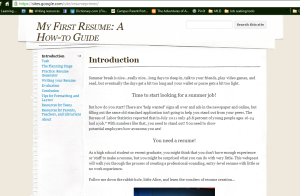
As great as it can be to have information at your fingertips, technology in the library isn’t just about pathfinders and webquests. Jamshid Beheshti of the American Society for Information Science and Technology, points out that “a growing body of research shows that children and young adults when seeking information under imposed tasks such as school projects encounter many problems and challenges” and are, in many cases, “information illiterate.”2 This is not surprising with the deceptive ease by which students can use Google and Wikipedia to conduct research, that the results they are turning up aren’t worth the paper they are scribbled on.
A reference or youth librarian is the ideal person to teach a middle or high school student how to use comprehensive databases, such as EBSCOHost or ProQuest, to find articles on current events, history, the arts and sciences, as well as a vast array of other topics.These are skills that not only make them better students, but also prepare them for college and to become informed citizens. Teaching our young people to utilize technology in the library and at school is like handing them the keys to their future, but their teachers and librarians’ efforts and expertise can be a determining factor in what type of future those keys unlock.
 Beyond just finding information, a library can also provide children and teens with the tools to communicate what they have found to their teachers, community, and peers through the written word, through visuals and graphics, and even through digital mediums such as podcasts or film. A responsive youth program will have a variety of software and presentation tools at their disposal and the know-how to instruct young patrons in how to use them. We are all familiar with Powerpoint, but what about Prezi? Or Frames?
Beyond just finding information, a library can also provide children and teens with the tools to communicate what they have found to their teachers, community, and peers through the written word, through visuals and graphics, and even through digital mediums such as podcasts or film. A responsive youth program will have a variety of software and presentation tools at their disposal and the know-how to instruct young patrons in how to use them. We are all familiar with Powerpoint, but what about Prezi? Or Frames?
Prezi is one of my favorite, free tools. It is an interactive, zoom and pan presentation medium that is an dynamic alternative to the same old, boring PowerPoint that we all snooze to in meetings. Frames 5, by tech4learning.com, comes with a small price tag but it well worth investing in. It is an easy to use animation tool for making short films and presentations (think Final Cut junior) that provides young patrons with an exciting presentation tool as well as an outlet for their creativity. And these are just two among many tools available!
A 2005 Pew Research Center report on teens and technology found that more, not less, young people are visiting the library for their online needs: 54%, up from 36% in 2000.3 This is an encouraging trend. Classroom teachers often do not have the time or resources to spend introducing students to research and information portals, presentation and communication software, or teaching the finer points of conducting productive research in our Google world. Libraries can and should.
With everything the modern library has to offer its young patrons – computers, databases, webquests, pathfinders, software, video games, and multimedia – it is a wonder they aren’t beating a path to our door! These types of tools and resources greatly enhance children and teens’ technological proficiency, increase their comfort level, and might even lead them to discover a passion for film, computer science, graphic design, or even librarianship. We are doing a disservice to young people if we neglect to include e-resources as fundamental tools in our arsenal for the war against illiteracy.
So boot up, login, and chart a course for more technology in the library! Your patrons will thank you.
Cited:
1Kathy Ishizuka, “Teens as Tech Wizards? Not!” School Library Journal, April, 1 2005 (http://www.schoollibraryjournal.com/article/CA514039.html)
2Jamshid Beheshti, “Teens, Virtual Environments and Information Literacy,” Bulletin for the American Society of Information Science and Technology, 38.3, February-March 2012, 54-57, (http://www.asis.org/Bulletin/Feb-12/FebMar12_Beheshti.pdf )
3Pew Research Center, Teens and Technology: Youth are Leading the Transition to a Fully Wired and Mobile Nation, July 25, 2005. (http://www.pewinternet.org/~/media//Files/Reports/2005/PIP_Teens_Tech_July2005web.pdf.pdf)
Screenshots:
“Ghoul Gate : A Graveyard Book pathfinder,” by me (https://sites.google.com/site/theghoulgate)
“My first resume: a how-to guide,’ also by me (https://sites.google.com/site/resumeprimer)
Prezi (http://prezi.com)
Frames 5 (http://www.tech4learning.com/frames)
Images:
“Kids on computer” from Google Images
“Success Keys” from Llenrock Real Estate’s blog (totally stolen)
A Review of Shelflister, an OpenSource Voyager Client
The University of Texas informational website for the Voyager client Shelflister describes this OpenSource program as a “client for generating real-time shelf lists” including charge statistics, browsing statistics, and item status (e.g. missing, charged, circulation review, etc). With the help of our automation librarian and a loaner iPad, I downloaded this program to find out if it was something that might be useful as part of the bi-annual shelf reading process at my library (a mid-sized academic library).
As a little background, we are still very low-tech in our shelf reading practices. Twice a year the 3rd floor library stacks are divided equally among the circulation staff. Then each shelf and row is manually read for call number order, to look for missing materials, and to check the condition of the materials. The entire process usually takes three or four months to complete as the shelf reading takes place in addition to the regular duties of the staff. Since we do not have a budget to purchase portable scanners and the magnetic or electronic tag systems that read a shelf with a pass, it was my hope that we might find a free application or client that could be used with existing software and materials (we have several iPads, for instance) that could speed up or automate this process.
The product I tested: Shelflister, a Voyager client written and made available by Michael Doran and his crew at the University of Texas at Arlington.
Copyright 2003-2012 by the University of Texas at Arlington
Cost: Free
Required Hardware Environment: Reports can be processed with a desktop PC but use in the stacks requires a compatible tablet or iPad (Bluetooth scanner optional).
Required Software Environment: The client is a platform independent PERL application that will run on most computers and Microsoft operating systems up to Windows XP.
The software and hardware environment: The trial was conducted using both an iPad and a PC running Windows XP Professional, service pack 2.
What happened: I loaded the program client on the iPad and was presented with a screen asking me to provide a starting barcode or call number and an ending barcode or call number in order to generate a list of what was included in that range. The data is pulled from the OPAC so I knew that it would display what should be located in that data range and not what was physically on the shelves.
For example, when I selected the call number option and entered “BS472.D6” and “BS475.3 .H9” for the start and end parameters, I was presented with a list of materials that should be on the shelf that I was reviewing at the time. Again, I had a choice as to how I wanted the data displayed. In this case: call number or title. Both displays let me know at a glance how often the items in this data range had been charged, their browsing statistics (if that information was available) and their current status (e.g. if they were currently charged, reported missing, etc). Selecting an individual item provided more detailed information on the status and the option to apply a status of my own. For example, if a book that should have been on that shelf was missing, I could have applied a lost status right there in the stacks.
Any status that is applied using the Shelflister app, however, does not impact or change the OPAC. Instead the information is listed as part of a librarian or staff-generated report at a later time. This allows student assistants or volunteers to conduct shelf reviews using this program with the oversight of a librarian or qualified staff member.
Some possible uses that immediately occurred to me was this application’s potential as a tool for weeding or maintaining a collection. An item that was obviously out of date, badly damaged, or otherwise unsuitable for circulation could be marked when it was noticed with the appropriate status and then weeded, replaced, or sent for mending as part of a bulk process at the convenience of the library.
Another perfect application for this program is the roving reference librarian model. When assisting patrons, a roving librarian would not have to return to their desk to determine the status of materials in the collection or to locate them on WorldCat. Additionally, unlike accessing the OPAC from the typical web browser on his or her mobile device, Shelflister would allow the reference librarian to report missing materials or an item in need of repair without interrupting their normal workflow.
Conclusion: For the purposes of shelf reading on a large scale (e.g. checking the call number order of an entire row or section), Shelflister is of limited use. The program generates a list of materials based upon what the OPAC indicates are in that call number range, but not what is actually on the shelf or whether the materials are shelved in the correct order. As a tool for reference and collection maintenance, however, it could be a welcome addition to an academic library that uses Voyager, especially when the program is available at no charge. The developers provide a great deal of user support and tutorials on their website that make it easy to use for someone with a basic to intermediate grasp of computer applications, though installation might require assistance from library automation or your IT department.
Though its functionality is limited to a Voyager environment and very specific purposes, the software does what it is designed to very well. I would recommend it for any academic libraries with a limited budget that want a little bit more functionality out of Voyager or who want to implement a roving librarian reference model.
| Pros: | Cons: |
| Allows for marking a status such as weeding, mending, lost, damaged, etc, for the purposes of processing materials at a later date. The voyager status does not change; instead a file is saved on the server. | Information that is generated for call number ranges reflects only what information is already available in Voyager. Does not account for mis-shelved items or lost items that are not yet known to be lost. |
| Easy to use; requires little training. | Requires a mobile device (iPad, tablet, or smart phone) and potentially a Bluetooth scanner. |
| Excellent for a “roving librarian” reference model or to help patrons locate books in the stacks since it displays real-time status of materials in the collection (charged, missing, etc). | Not a good tool for shelf reading or inventory because it doesn’t tell us anything we don’t already know (e.g. if a book is missing from a section but not yet reported missing). |
| Aids in making decisions on weeding by having browsing and charge data available at a glance. | Not compatible with other common cataloging environments, such as Evergreen |
| Free | Software support is primarily of the do-it-yourself variety. |
| Compatible with Voyager | |
| A variety of self-help tools are available on the applications website including PowerPoints, manuals, and tutorials. |
